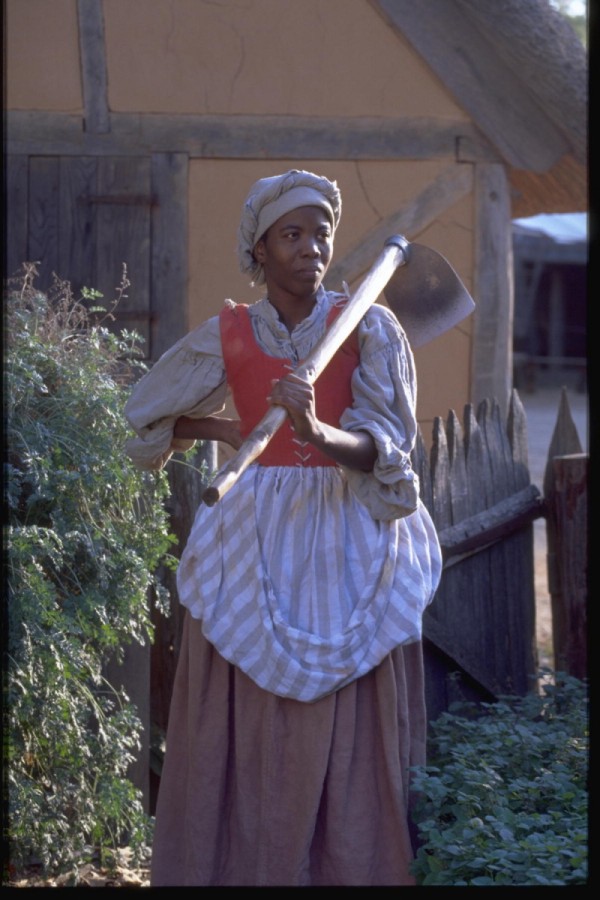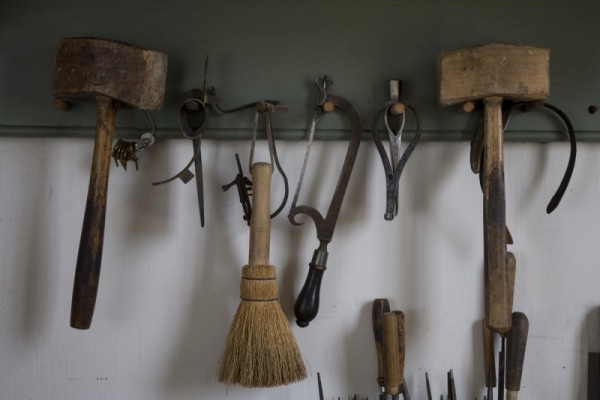 By Karen Gonzalez
By Karen Gonzalez
Imagine a typical day in 18th-century America.
Workers headed to the tobacco field before sunrise with hoes and shovels slung over their backs. The house cook placed the first pots of water to boil on the fire. A large fire was lit at the blacksmith shop, where the tools were laid out for the day.
The workers in these cases were enslaved – and the tools are part of their American story.
From 17th-century survival to 18th-century everyday life
What was once a necessary implement for survival in a developing world became a means to understand the lives of enslaved persons in colonial America.
Early 17th -century settlers used axes and saws to cut countless trees to build the first shelters, fuel fires for cooking and warmth, and build furniture. In the 18th century, enslaved men and women were defined by the tools of their trade. Whether perfecting their skills in the master’s trade shop, working in the tobacco field or cooking food in the kitchen for an entire household, tools provided the help they needed every day.
You just can’t make soup without a pot
From shovels to rulers, calipers to needles, tools allowed the worker to move the picture in their mind to a final product.
Field hands used tools such as hoes, rakes, shovels and plows, not to mention the animals to bear the burden of the heaviest pulling and lifting.
Kitchen tools were used primarily by the female domestic slaves. Their pots, griddles, saucepans, utensils and bowls were just as critical to them as the clothes on their backs. After all, how do you make soup without a pot, or butcher a hog without a knife?
Eighteenth-century tradesmen‒free and enslaved‒ used their tools to create the utilitarian and decorative objects desired most by their customers. Tools such as gluepots, lathes, saws, brushes and planes were kept with great care and highly valued.
One man’s trash is another man’s tool kit
One popular way to get tools was to make them from old and broken pieces of other tools, according to “Tools ‒ Working Wood in the Eighteenth Century America,” a book by Jay Gaynor and Nancy Hagedorn.
“In addition to the tools provided by their master, slaves often acquired tools in this way, creating very useful items from what most people considered trash. It was not unusual for a runaway slave advertisement to describe skilled workers carrying off their tools with them,” said Rose McAphee, a historian and interpreter at the Colonial Williamsburg Foundation.
“No doubt men like Ben‒ who ran away from Joshua Jones in 1769 and “…took with him sundry carpenters and coopers tools” ‒understood the importance of tools to the success of every tradesman,” McAphee added.
Immigrant craftsmen brought their finest and most modern tools with them from their homeland, helping educate American craftsmen in the latest advances of tool technology.
Before toolmakers were available on the American continent, new tools had to be ordered from England. Tools from overseas typically required two, three or more months to arrive.
American toolmakers began opening shops during the early 18th century, creating competition for English toolmakers. Suddenly new tools could be ordered and received within a much shorter time.
Alternatively, one might purchase tools for less money through local markets, consignment shops and retiring workmen. Some stores accepted old tools as a trade-in for new.
Bartering to acquire tools was a favorite method among slaves and poor whites who could not afford to purchase them. It was also a common practice for work or goods to be traded for store credit.
Wealthy landowners such as George Washington and Thomas Jefferson had the means to provide the necessary tools for their slaves. This was a rare opportunity for slaves to experience the finest and most up-to-date tools at no personal cost.
Who needs power tools?
How did they create such beautiful products with primitive hand tools?
While most of us today would not consider drilling a hole without a power drill, 18th-century enslaved carpenters valued their auger for drilling holes by hand. Human muscle was obviously a major part of the equation.
In 2015, we wouldn’t even consider cutting a plank without a table saw, but 18th-century workers labored in teams to cut planks using a two-manned crosscut saw.
Except for the introduction of electric power, tools have changed very little in 400 years.
Archaeologists have made surprising discoveries in the tools they found. Eighteenth-century tools were not as primitive and crude as previously thought. Many had remarkable elegance and complexity, along with the fit and balance of the highest standard.
Every tool tells a story
Enslaved men and women used tools to help them with their work as nothing less than a favorite friend and partner, aiding them in every aspect of their lives. The worn grooves fit the hands of the workers who used them and often the tool becomes like an added appendage. The stories of these tools continue to be told. They are yet another link to the enslaved, their stories, their life and their work.
Mona Agrue says
I need help identifying tools that were used on the farm in 1800s by slaves
Katherine Warden says
I work as an Interperter with groups and in the buildings and this is added information for me to add to and work with in my working with people of all ages. Thank you.
Steve Burnham says
I enjoyed this very much. It may be tempting for the reader to think “I knew that”, but I had not considered the influence of tools on the daily lives of the people of that time. Nor had I considered the difficulty of obtaining tools then.
Please keep up the good work.
David Keller says
What an enlightening and educational article! I had no idea that tools played such a pivotal economic and cultural role within slave communities. I can easily see how the complexity, or lack thereof, of tools used, could have added to the quality and/or misery of the lives of these poor souls.
Thank you for your comments. We are happy that the article was educational for you. Do check back often for more enlightening articles.